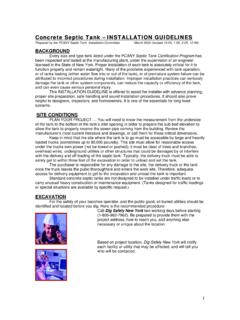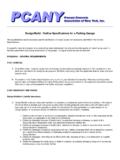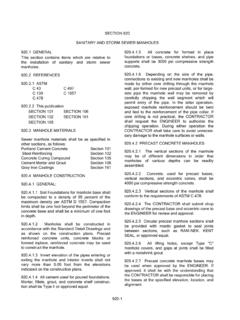Transcription of Vacuum Testing of Precast Manholes
1 Vacuum Testing of Precast ManholesVacuum Testing can be a great time and cost savings during the construction process to verify top quality manufacturing and water tightness of Precast Manholes and their components. This is particularly true when compared to hydrostatic test methods. Vacuum Testing can also be a valuable method of verifying the quality of Manholes in-plant before shipment to the job site. However, the scope and general procedures for this valuable test may be unclear. ASTM C1244 - Standard Test Method for Concrete Sewer Manholes by the Negative Air Pressure ( Vacuum ) Test, defines the requirements for Vacuum Testing Manholes . The intent of this standard was to provide a preliminary test to enable the installer to demonstrate the condition of the Manholes before backfilling. However, the standard also permits post-backfilling without explicit recommendations. This discussion defines the purpose of Vacuum testings and provides some helpful suggestions for its execution.
2 Understanding the intent of the standard is particularly important in cases where municipalities require Testing after backfilling. STANDARD TEST PROCEDUREThe standard Vacuum test is performed on non-backfilled Manholes , to verify the adequacy of the Precast manhole. The test requires that all lift holes, pipes, and other penetrations be plugged prior to Testing and that the test apparatus be directly applied on top of the concrete surface of the manhole following the manufacturer's recommendations, rather than to the cast iron seating ring. All pipes entering the manhole, plugs and seals must be securely braced to prevent them from being dislodged and drawn into the manhole during the Vacuum test. Figure 1 illustrates typical recommendations for Testing before backfilling. Once all penetrations are sealed, the test proceeds by drawing a Vacuum of 10 inches (254 mm) of mercury. After reaching 10 inches of mercury, the time is recorded for the Vacuum pressure to drop to 9 inches (229 mm).
3 If the time required for the Vacuum to drop to 9 inches exceeds a prescribed period (Table 1), based on the manhole's depth and diameter, the manhole is acceptable. Leaks can be readily detected by finding the source of a hissing sound as air enters the manhole. Leaks can also be detected by spraying water on the exposed wall surface - escaping air will produce a dry spot. If the manhole fails the initial test, repairs are affected and the assembly is re-tested until a satisfactory test is obtained. Repairs are often performed by placing a grout slurry on the exterior of the leak - the Vacuum in the manhole pulls the slurry into the needed area and the manhole is sealed. BACKFILLED TESTV acuum Testing after backfilling should only be performed after a successful non-backfill test has been completed. ASTM C1244 requires that special precautions by employed in post-backfill Testing by directing the user to the connection supplier for proper testings methods.
4 These recommendations also require plugging of all pipes entering the manhole, securely bracing all plugs, pipes and seals. They may also require additional measures to assure protection of all gaskets and seals. Figure 2 illustrates typical recommendations for Testing after backfilling. Leak detection is a more timely process for a backfilled manhole. However, leaks can be found by using a soapy solution liberally coated on the interior of the manhole. Solutions of 2 to 10 oz. (60-470 ml) of liquid soap per gallon have been recommended for ambient temperatures below 80 degrees F (27 degrees C). A similar solution with a few ounces of corn syrup is recommended for temperatures above 80 degrees F. Bubbles will form at leaks. Repairs after backfilling are also more difficult. In some cases, regulators require excavation of the manhole for exterior repairs, re- Testing prior to backfilling, backfilling and then re- Testing again.
5 CONCLUSIONIt is normal practice to test Manholes for water tightness during installation. The Vacuum test is a time and cost savings method offered as an alternative to hydrostatic Testing (ASTM C 969) and is not meant to preclude acceptance by that or other standards. It is also not meant to serve as an in-service leakage tests for other environmental structures, ASTM C 1244 should be performed before backfilling so any leaks can be readily found and repaired. If Testing after backfilling is required, it should be done only in conjunction with Testing prior to backfilling. References:ASTM C1244-93, Standard Test Method for Concrete Sewer Manholes by the Negative Air Pressure ( Vacuum ) 350R-89, Environmental Engineering Concrete StructuresASTM C969, Standard Practice for Infiltration and Exfiltration Acceptance Testing for Installed Precast Concrete Sewer Lines.




